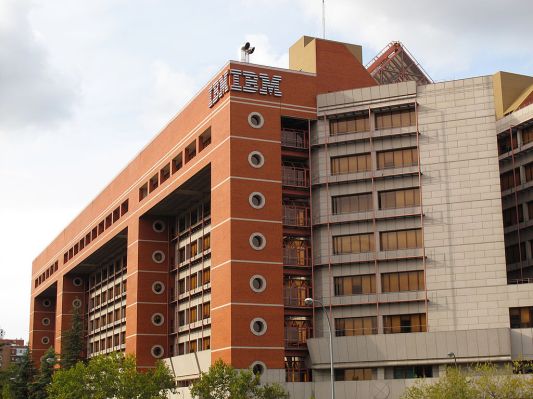By all accounts, yesterday was a great day in IBM’s recent financial history. It said its revenue rose 6.5% in Q4, the highest in years. Investors liked the results, and the stock rose in after-hours trading. That is, until CFO Jim Kavanaugh answered a question on the company’s earnings call about its earnings per share projections for next year, and the rally sputtered — at least for a time.
Fast forward to this morning, and investors are apparently focusing more on the good news and ignoring the bad. What did Kavanaugh say that briefly caused the stocks to reverse direction? Stifel Financial Corp. analyst David Grossman asked a question about EPS (earnings per share estimate), and that’s when Kavanaugh made clear the company wasn’t going to be playing that game.
“And I’m a very big believer in focus. And that focus is around two measures: revenue growth and free cash flow. So, I am not going to talk about EPS guidance. And by the way, EPS, as you know quite well, there are many ways of getting to an EPS number,” he said on the call.
What’s the CFO on about?
Putting on our accounting hats, what the CFO is discussing is not corporate pablum. IBM is aiming to reignite growth, the revenue component of Kavanaugh’s comments. The free cash flow piece is a bit more nuanced, but it matters that IBM is focusing on growth more than profitability.
Free cash flow is a company’s operating cash flow minus its capital expenses. It’s a popular method to track loose “profitability” in startups that are more growth-focused than profit-tuned; major companies use EPS to vet their performance when growth has slowed. Free cash flow, by not accounting for certain costs like share-based compensation, can give investors a simpler view of whether or not a company’s growth is self-sustaining.
IBM’s debt situation helps explain why cash flow matters so much. In 2021, the company had free cash flow of $6.5 billion. Given its relatively high debt load — some $6.8 billion in short-term debt, and $44.9 billion in long-term obligations — it matters whether or not IBM can both expand its revenues while not burning cash. If the answer is no, the company could be forced to seek additional capital, either in the form of new debt or an equity sale. Positive free cash flow and growth implies that IBM is not burning tomorrow’s funds to finance its present-day growth.
Of course, investors love a good EPS number. But for a company that is working to rebound, having a tight set of goals is hardly a sin.
New strategy taking shape
CEO Arvind Krishna was ecstatic in a meeting with analysts after the report, seeing it as a reinforcement of his strategy to get the company back on track. “Our fourth-quarter results reinforce our confidence in our strategy and model. With solid revenue growth, we are on track to the mid-single-digit trajectory we had laid out in our investor briefing last October. The trend we see is clear,” he told analysts.
Holger Mueller, an analyst at Constellation Research, says investors have been waiting a long time for a quarter like this. Mueller believes that by offloading some assets, the company is in a better position for the future.
“Good to see IBM finding back the growth that has eluded the vendor for longer than any investor would have liked. But a small ship can sail faster, and with Kyndryl and Watson Health assets being offloaded, it will help make IBM sail faster,” he said. He wonders, though, if the bet on hybrid cloud will be enough to keep the company on track permanently.
The centerpiece of that hybrid cloud strategy is Red Hat, the company IBM acquired in 2018 for $34 billion. Krishna certainly thinks so. “It starts with Red Hat, which offers clients unique software capabilities based on open-source innovation. Our software, which has been optimized for that platform, helps our clients apply AI, automation, and security to transform and improve their business workflows,” he said on the earnings call, calling out some of the other key pieces of IBM’s approach.
Bola Rotibi, an analyst at CCS Insight, says the focus on Red Hat, in conjunction with the other pieces, could be a winning strategy. “Certainly, many of the ingredients are there to meet their growth goals: the pivotal role of the Red Hat portfolio with its double-digit growth, renewed vigor in its consulting services, in-organic growth through 15 acquisitions, and an ever-expanding partner ecosystem,” she said, pointing to the company’s more traditional products like its Z mainframe.
“New product cycles of its core infrastructure products such as the IBM Z mainframe platform will help to demonstrate their continued value,” she said.
Like Mueller, Rotibi says the company needs to prove it can sustain this over the long haul, “However, many will still be looking to see the stability of that growth when the dust fully settles from the Kyndryl divestiture and operations assume a level of normality.”
IBM has been trying to find its way in the modern tech world for some time. It started with former CEO Ginni Rometty a decade ago, and it has continued under Arvind Krishna, who came on board in 2019. Krishna has attempted to put his own mark on the company, and it appears to be finally paying off, but time will tell if this report is truly part of the sustained growth trend Krishna is hoping for.
